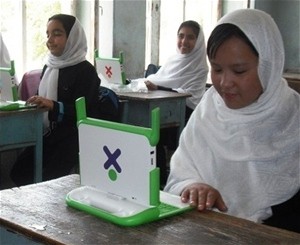
Afghan students now have the opportunity to learn using computers and the Internet thanks to USAID, the One Laptop per Child Foundation, the Afghan Government, and private sector partners.
USAID/ASMED
Public-private partnership provides Afghan students with One Laptop per Child computers.
24 DECEMBER 2009 | KABUL, AFGHANISTAN
Each morning, Hamida, an eleven-year-old student in Kabul, packs her schoolbag. Alongside her pens and books, she carries a bright green-and-white laptop. “It’s like a friend and teacher to me,” she says. “I can look and try to solve questions and spend my time learning.”
After years of war, instability, and times when such technology was banned, USAID is bringing laptops designed to improve education into Afghan schools. Computers like Hamida’s provide students with vast educational resources including digital libraries, educational pages, word processing, databases, and access to email and the Internet.
This classroom of the future is being piloted in Afghanistan today thanks to an innovative public-private partnership between USAID, the U.S.-based One Laptop per Child Foundation (OLPC), the Ministry of Education, the Ministry of Communication and Information Technology, Roshan Social Programs, and Afghan IT company Paiwastoon Networking Services.
The laptops, designed by OLPC, use just a quarter of the energy of a regular laptop and can be either solar or foot powered. With 7.5” high-resolution screens that can be read in the dark and in direct sunlight, and watertight protective outer cases with Dari or Pashto keyboards, they are well suited to overcome the unique challenges of Afghanistan.
The laptops are not only for use in the classroom. Equipped with Internet connectivity, educational software, and a small business tutorial and market information toolkit provided by USAID, the computers are a valuable tool for the entire family. Each evening, the laptops go home with the students, whose families can accessing training and resources to develop and improve their businesses. Even in the most remote regions of Afghanistan, students and entrepreneurs are connecting to the world.
USAID combined these local private and public sector resources as part of an innovative public-private partnership. This successful venture improves Afghanistan’s educational system and rebuilds the country’s human capacity, creating opportunities for much-needed income generating activities.







Comment
Make a general inquiry or suggest an improvement.